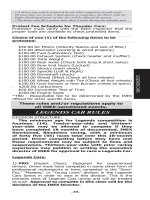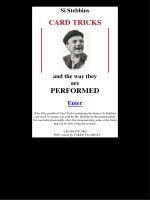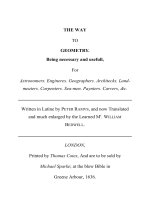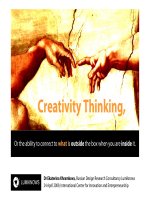- Trang chủ >>
- Khoa Học Tự Nhiên >>
- Vật lý
personality what makes you the way you are oct 2007
Bạn đang xem bản rút gọn của tài liệu. Xem và tải ngay bản đầy đủ của tài liệu tại đây (1.38 MB, 305 trang )
Personality
This page intentionally left blank
Personality
WHAT MAKES YOU THE WAY YOU ARE
DANIEL NETTLE
1
3
Great Clarendon Street, Oxford OX26DP
Oxford University Press is a department of the University of Oxford.
It furthers the University’s objective of excellence in research, scholarship,
and education by publishing worldwide in
Oxford New York
Auckland Cape Town Dar es Salaam Hong Kong Karachi
Kuala Lumpur Madrid Melbourne Mexico City Nairobi
New Delhi Shanghai Taipei Toronto
With offices in
Argentina Austria Brazil Chile Czech Republic France Greece
Guatemala Hungary Italy Japan Poland Portugal Singapore
South Korea Switzerland Thailand Turkey Ukraine Vietnam
Oxford is a registered trade mark of Oxford University Press
in the UK and in certain other countries
Published in the United States
by Oxford University Press Inc., New York
c
Daniel Nettle 2007
The moral rights of the author have been asserted
Database right Oxford University Press (maker)
First published 2007
All rights reserved. No part of this publication may be reproduced,
stored in a retrieval system, or transmitted, in any form or by any means,
without the prior permission in writing of Oxford University Press,
or as expressly permitted by law, or under terms agreed with the appropriate
reprographics rights organization. Enquiries concerning reproduction
outside the scope of the above should be sent to the Rights Department,
Oxford University Press, at the address above
You must not circulate this book in any other binding or cover
and you must impose the same condition on any acquirer
British Library Cataloguing in Publication Data
Data available
Library of Congress Cataloging in Publication Data
Data available
Typeset by SPI Publisher Services, Pondicherry, India
Printed in Great Britain
on acid-free paper by
CPI Mackays Ltd., Chatham
ISBN 978–0–19–921142–5
13579108642
Contents
Introduction 1
1. Character Matters 15
2. The Beak of the Finch 54
3. Wanderers 79
4. Worriers 104
5. Controllers 131
6. Empathizers 155
7. Poets 183
8. The Other Half 210
9. Singing with Your Own Voice 234
Appendix: The Newcastle Personality Assessor 249
Notes 254
References 274
Index 294
At every single moment of one’s life one is what
one is going to be no less than what one has been.
Oscar Wilde, De Profundis
Introduction
I do not plead guilty to a shallow view of human nature, when I
propose to apply, as it were, a foot-rule to its heights and depths.
Francis Galton
Lee is a successful, smart, business executive, rising 35 and
rising through the ranks at the same time. He is considered
effective and dynamic at work. In fact, it’s more than that.
He does not suffer fools gladly, and if he thinks colleagues or
suppliers are trying to pull one over on him, he is quick to
speak his mind. He can be very cutting, and fly into a deep
rage, during which he will tell people what he thinks of them
and their behaviour without sparing their blushes. As a result,
though he is good at what he does, he builds up enemies. He
has moved firms a few times, or had to be moved between
departments, because he gets into feuds and stand-offs. Some
more conciliatory colleague will have to step in to calm the
waters, or simply to ensure that Lee and his latest enemy
don’t have to deal with each other.
2 Introduction
Outside of work, there are quite a lot of people Lee doesn’t
like. He has been to a fair few exotic countries, and for at least
some of these, he has decided that he hates the natives. They
are too rude, or too slow, or invade his personal space. He
hates people who cut him up on the road, or barge in front of
him in line, or make him wait. He is quick to get angry when
this happens, and not averse to a muttered, usually scatolog-
ical, insult. We should not assume that Lee doesn’t like to
socialize. In fact, he loves to go out and party. However, if the
people at the party are the wrong type of people, or they are
partying in the wrong way, he is quickly bored and frankly
annoyed at having wasted his evening. Even a good party
might end up with Lee in a screaming row with some fool
who doesn’t share his politics or tastes.
Lee has a core of good friends, and these friendships have
lasted, but they are not without conflict. In fact, in each, there
is a history of strong arguments, altercations, and sulks, as
well as reconciliations. Love is a similar story. There always
seem to be disagreements, or the other person turns out to
be needy, annoying, or inadequate in some way. Women tend
to end up saying Lee is selfish, or inconsiderate, and a partner
who is compatible for the long haul is still not in sight.
Julian is very different from Lee. He is (currently) a writer
for a travel magazine. This job allows him to travel all over
the world, researching stories on Indian religious festivals
and the Trans-Siberian Railway. Travel is his current passion,
Introduction 3
though it was not always so. He studied music at college,
and immediately after graduation threw himself with passion
into his band, which performed an unusual combination of
traditional Middle Eastern music and modern pop. Guided
mainly by his motivating enthusiasm, the band did quite well
in their region for a few years, though doing quite well in
the music business is not as g lamorous as it might seem. It
means playing live, a lot, but to maybe thirty or fifty people,
and sleeping in vans and sharing flats with numerous others
of uncertain hygiene. These costs are not to be questioned,
though, since music is clearly ever ything.
A couple of years into the life of the band, Julian began
to become disillusioned, and for a period became low and
withdrawn. He felt that his life with his partner, one of
the band’s Lebanese backing singers, was becoming repeti-
tive and joyless, and he worried about what would happen
to them in the end. What had previously seemed incredi-
bly exciting flipped into seeming like a treadmill on which
they would never get anywhere. Julian eventually left both
the band and his partner and, much to the surprise of his
friends, enrolled in a Master’s degree in business manage-
ment. Julian, the rock and roller, in a business suit? Julian
would have none of it. Business is really interesting. It’s about
people, it’s about how they interact. In fact, it’s creative.It’sa
way of bringing about new relationships and better ways of
living.
4 Introduction
Needless to say, that didn’t last. By the time of graduation,
Julian could only see the entrapment of thirty years of 9-to-5
working in an office ahead of him. This time he became really
depressed, and saw both a doctor, who prescribed antide-
pressants, and a counsellor, who introduced him to some of
the more New Age elements of psychotherapy. For a while
he made his living, with his then g irlfriend, doing Reiki,
psychodrama, and Indian head massage, the two of them
living frugally but healthily in a large rambling farmhouse in
a remote spot. They didn’t need foreign holidays, so vivifying
and healthy was the way they lived all year around.
That lasted three years, until a rift with his partner, and
disillusion with the therapies he was practising, led Julian
into his glummest spirits yet. He resolved to travel the world
for a year, to revitalize himself, and through a series of chance
encounters, ended up writing features for the travel mag-
azine. He loves his job—he has been doing it for a year—
and has a fabulous French girlfriend, who is a photographer.
Clearly, travelling and travel writing is what he has always
been working towards.
Their lives are so different, Lee and Julian, and yet they are
the same age and sex. We can easily imagine them both com-
ing from fairly normal middle-class backgrounds, being of
similar intelligence and educational attainment, and having
been exposed to broadly similar cultural expectations and
values. In fact, it is no stretch of the imagination, given our
Introduction 5
experience of human beings, to imagine two people having
essentially the same set of experiences growing up, and yet
having adult lives at least as different from each other as
those of Lee and Julian. If the initial social conditions were
so similar, then what could possibly account for two human
lives coming out so differently?
Non-psychologists I talk to have strong intuitions about
this question. What brings about the different outcomes is,
they say, the different personalities, or temperaments, or
characters, of the two individuals involved. What is person-
ality, I ask? They tell me that it is something internal, stable,
inherent to the person, something which stands in a causal
relationship to their specific choices, motivations, reactions,
and obstacles when faced with the stream of events. A clue to
personality being at work, they tell me, is a kind of thematic
recurrence within the events of a life. For example, over the
course of a few years, Lee eventually ends up hostile about
most of the people he has to work with. In the same way,
he is quite likely to end up being hostile about someone he
has to sit next to on a train journey or flight. The timescale is
quite different, and the stakes and demands of the interaction
are very different, but the fact that, sooner or later, another
person in close proximity is likely to do something to annoy
him, recurs as a leitmotif across Lee’s life. (A leitmotif I suspect
Lee will never consider, since he finds psychologists and psy-
chology books really annoying.)
6 Introduction
Similarly for Julian, there are a number of recurring pat-
terns. Each of the domains of fusion music, psychodrama,
self-sufficient farm living, and travel writing is unusual and
creative, but Julian has been drawn to them all within a short
life. It is as if there is a constant quest for new ways of expe-
riencing the world and expressing his experience of it. There
is also a characteristic pattern to his life choices. He finds a
new domain and becomes tremendously, infectiously excited
and activated by it. This serves him very well in getting his
new projects established. For a while, he simply will not hear
of the drawbacks or limitations. Over time, though, these
feelings fade, and in place of enthusiasm come doubt and
worry about the future, for despite his energy, Julian can be
a very worried and sad person.
The pattern that describes Julian’s career activities also
describes his relationships. These have typically lasted two or
three years, and consisted of an initial phase of great passion,
during which his family’s mild suggestions of unsuitability
are just so ridiculous, unintuitive, and superficial, followed
by a period of mounting unhappiness, restlessness, and with-
drawal, during which his family’s resigned attempts to get on
with his chosen paramour are resented. (‘How can they not
see that she is not what I need?’ It is the lot of parents to
always be in the wrong.) This phase is followed by a period
of more or less nervy adjustment and recuperation, before
the next passion takes hold.
Introduction 7
Can this leitmotif of initial enthusiasm, followed by with-
drawal and denial, be detected at any other level? As I
imagine him, Julian has dozens of unopened books that
he brought home from the book shop with a triumphant
‘Nietszche is so interesting. I am going to read everything
he ever wrote’. There is a bread maker, bought in a flurry
of excitement but used twice, a violin, played once, and a
full-sized loom(!) Each of these items represents a spurt of
enthusiasm and a desire to begin something unusual, fol-
lowed by either insufficient reward to sustain the behaviour,
or a slough of demotivating negative emotion. This is the
same pattern as the relationships and jobs, but over a different
scale.
The same pattern appearing at different scales is a very
interesting property. It is, for example, a property of those
exquisite topographies called fractals much beloved of com-
plexity theorists and graphic designers. In a fractal, you see
the same pattern whether you look at a very large section or
whether you zoom in on a very small one. The part repre-
sents the whole, and vice versa. Fractals have this property
because of the nature of the mathematical functions that
generate them.
Human personalities are rather like fractals. It is not
just that what we do in the large-scale narratives of our
lives—love, career, friendships—tends to be somewhat con-
sistent over time, with us often repeating the same kinds of
8 Introduction
triumphs or mistakes. Rather, what we do in tiny interactions
like the way we shop, or dress, or talk to a stranger on a train,
or decorate our houses, shows the same kinds of patterns as
can be observed from examining a whole life. We often find
ourselves saying, ‘That is just so typical of Bob ’. We say
this because what people do in the set of situations we have
observed them in is a reasonable guide to what they will do
in a set of future situations, including quite different ones.
Just as the self-consistent properties of fractals are generated
by the mathematical functions that define them, so the self-
consistent properties of personality seem as if they are gener-
ated by some physical property of the nervous system of the
person in question. In other words, we feel that talking about
someone’s personality is a shorthand way for talking about
the way that person’s particular nervous system is wired up.
1
This book is about the psychology of personality. I aim
to vindicate the idea that people have enduring personal-
ity dispositions which partly predict what they will do, and
which stem from the way their nervous systems are wired
up. I also wish to introduce the science behind the study
of personality—how we measure personality, what the mea-
sures mean, what they predict, and why personality varia-
tion exists in the first place. Personality psychology has, until
recently, had a rather low status compared to other branches
of psychology. It has been perceived as based on flimsy
evidence, internally divided, and far removed from the ‘hard
Introduction 9
science’ end of psychology. There may once have been some
justice in these views, but I believe that things have changed.
In fact, a renaissance is underway in the study of personality,
a renaissance I hope to herald in this book.
There are several reasons why the time is right for the
renaissance. First, we at last have a set of personality concepts
we can use that is firmly based on evidence, and which we
psychologists can agree on. This set of concepts is called
the five-factor model of personality, or the big five. The five-
factor model has emerged from a welter of research over the
last few decades and looks to be the most comprehensive,
reliable and useful framework for discussing human person-
ality that we have ever had (Chapter 1). The idea of the model
is that there are five major dimensions along which all human
characters vary. Thus, any individual can be given five scores
that will tell us a great deal about the ways they are liable to
behave through their lives.
The emergence of the five-factor model is very useful,
because the field of personality research had long been
plagued by different people using different notions. Formerly,
one psychologist might give you a score for Reward Depen-
dence and Harm Avoidance, whilst another might classify
you as a Thinking, Feeling, Sensing, or Intuiting type. This
led to a frustrating profusion of different studies measuring
different constructs without seeming to relate to each other
in any systematic way. All this added to the low status of
10 Introduction
personality research as a scientific endeavour. As long ago as
1958, Gordon Allport complained that ‘each assessor has his
own pet units and uses a pet battery of diagnostic devices’,
and things got worse in the ensuing decades.
2
The five-factor model introduced some order into the
mess. It’s not that all those other constructs were necessarily
invalid. It’s just that most constructs that had previously been
measured can actually be subsumed under the five-factor
framework—either they measure one of the big five, or a
sub-part of one of them, or an amalgam of two of them.
This is enormously useful, as we can quickly tidy the field up
very significantly, and give people a fully portable framework
for understanding and characterizing the main differences
between people. To quote the influential personality psychol-
ogists Paul Costa and Robert McCrae, the five-factor model
is the ‘Christmas tree’ on which all the particular findings
of personality research can be arranged. I am using the five-
factor model as my Christmas tree in this book too: each one
of the big five is the subject of one chapter (Chapters 3 to 7
inclusive).
3
Another reason that we are ready for a renaissance of per-
sonality studies is the staggering progress of neuroscience,
fuelled in particular by brain-imaging techniques such as
PET scanning and fMRI, which we will meet frequently
later in the book. These techniques allow us to look at the
structure and functioning of the human brain non-invasively
Introduction 11
in alive, awake, thinking individuals. The first flurry of activ-
ity using these new technologies was about finding out how
brains in general worked—which regions were always asso-
ciated with which types of functions—but a second phase
has become concerned with the variation between individ-
uals. Different brain structures have different relative sizes
within the ‘normal’ population, and there is a great deal of
variation between individuals in the way their brains respond
metabolically to particular tasks. A new science is emerging
of individual differences in brain structure and functioning,
and the results of this science can be mapped back to the big
five personality dimensions, as we shall see.
The third area contributing to the renaissance of interest in
personality is human genetics and genomics. The sequencing
of the human genome was completed in 2001. Just as in brain
imaging, the first concern was understanding people in gen-
eral, not as individuals. The initial goal of the human genome
project was thus to describe the common structure of the 25–
30,000 genes that we all share, and was based on a ‘consen-
sus’ sequence of around two hundred individuals’ DNA. The
consensus sequence has now been published, and there is a
growing interest in genetic individuality. Many of those 25–
30,000 genes exist in several slightly different variant forms.
We know that people vary enormously in disease liabilities,
response to particular drugs, vulnerability to specific types
of psychological problems, and many other ways, and we
12 Introduction
are beginning to understand how these predispositions relate
to which of the possible genetic variants they are carrying.
We all know our blood group, and, in the not too distant
future, we can envisage a world in which we will get our
personal genome sequenced, in order to know our vulner-
ability to breast cancer or heart disease, or likely response to
a particular type of drug. This burgeoning science of genetic
individuality can also be linked back to personality, since, as
we shall see, your personality is partly determined by which
genetic variants you are carrying.
The final reason why the time is right for a personal-
ity renaissance is to do with the diffusion of evolutionary
thinking. Evolutionary thinking is about asking the ultimate
question of how the population got to be the way it is
through natural selection, alongside the proximate question
of which genes or bits of brain are involved. Evolutionar y
thinking is becoming much more widespread in psychology,
and it is lending a new depth and explanatory power to
several different areas of the field. Just as in the other areas
of science discussed above, the initial concern of evolution-
ary psychologists was with understanding the design of the
mental mechanisms we all share, and so at first, they gave
relatively little thought to differences between individuals.
Only a few small forays of evolutionary thought into the
psychology of per sonality were made. However, that is also
changing. We know that there are temperamental differences
Introduction 13
between individuals in species other than humans. An evolu-
tionary perspective on such variation raises a host of good
questions. Why is the variation there? Will natural selection
ultimately eliminate it, or lead to its increase? Under what
circumstances, indeed, does natural selection allow variation
to persist within a population? These questions will infuse
our thinking about personality traits throughout this book.
4
This book is aimed at the interested general reader, rather
than just my academic colleagues. In this spirit, I will not
dwell on the kinds of technical details and full background to
every claim that would normally be found in a research paper
or monograph. Those wishing to find citations and ancillary
details are directed to the endnotes, though even these offer
pointers and key references rather than a complete litera-
ture review. Those who can live without the academic stuff
should be able to ignore the notes completely without miss-
ing anything vital to the argument. Even in this (hopefully)
user-friendly presentation, I will try to give a judicious and
evidence-based account of current knowledge, and be fair in
separating what we know from what is as yet guesswork. My
account is based on several elements: the existing literature,
created by many esteemed colleagues; some recent person-
ality studies of my own; and a remarkable set of life stories
sent to me by correspondents from all over the world. These
were individuals who had been participants in my research,
and for whom I thus had five-factor personality data. At my
14 Introduction
request, they kindly wrote to me—often at length—about
their lives, their feelings, and their relationships with others
in ways that have been most enlightening, even if they have
sometimes made writing this book harder, rather than easier,
since they make the picture more complex. Where I draw on
their stories, I have of course disguised details to ensure their
anonymity. (By the way, Lee and Julian are not examples of
these life stories. They are the only fictional case studies in
this book. The rest are drawn from life.)
I solicited the life stories because I suspected that most
readers of this book were more interested in understanding
people than in understanding personality theory for theory’s
sake. Above all, if you are reading this, I suspect you want to
know about and understand your own personality. I would
therefore urge you to turn to the Appendix and score yourself
using the Newcastle Personality Assessor before we go any
further and you know too much about what is riding on your
answers. You may like to have your scores to hand as you read
the subsequent chapters, especially Chapters 3 to 7, where
we meet the big five one by one. Before we can meet them,
though, we have to explore a couple of preliminary but vital
issues: first, in Chapter 1, what is a personality trait; and then,
in Chapter 2, why does evolution allow biological differences
between individuals of the same species to persist?
1
Character Matters
Personality is and does something Itiswhatliesbehind specific
acts and within the individual.
Gordon Allport
It might be conventional to begin with Hippocrates, and his
ideas about the four humours, or with some other ancient
conception of personality types. I prefer, however, to begin
our story with an article published by Sir Francis Galton in
The Fortnightly Review for 1884 entitled ‘The Measurement
of Character’. Galton is an apt place to begin for a number
of reasons. As Charles Darwin’s first cousin, Galton was an
early champion of evolution and of the view that evolution
is relevant to humans. The way he could think of applying
it was filtered through his Victorian preconceptions about
society and societies, and so does not seem appropriate to us
today. However, his basic intuition that the theory of natural
16 Character Matters
selection would ultimately have to inform our thinking about
everything people do has tur ned out to be correct.
1
A second reason for interest in Galton is that it was he
who first realized that studies of how characteristics ran in
families, and particularly studies of twins, were the key to
unlocking the contribution of nature and nurture to human
variation. This insight lies behind a whole scientific field,
known as behaviour genetics, a field that has flourished since
Galton’s time, and whose results we will meet later on.
Finally, Galton is noteworthy because he had a very mod-
ern preoccupation with measurement. Galton was obsessed
with trying to find practical measures for obscure bits of
human behaviour. In 1885, he published a paper in Nature
entitled ‘The Measurement of Fidget’. In this he notes, from
his own extensive observations, that in a large gathering such
as a lecture, audience members fidget around once a minute
on average. However, when the lecturer really holds their
attention with a point, this rate is diminished by around a
half, and moreover, the fidgeting changes. The period of the
movements reduces (an enthralled audience member gets
their movement over as quickly as possible, whereas a bored
one draws it out), and the angle of deviation of the body
from the upright (which sailors will know as the ‘yaw’) also
reduces. Thus a quick index of how bored an audience is at
any point in time would be on average how far from ver-
tically upright they were. Galton commends these insights
Character Matters 17
to the reader as promising to give ‘numerical expression to
the amount of boredom expressed by the audience generally
during the reading of any particular memoir’.
2
Quirky as this paper is, it is very modern. Many philoso-
phers before Galton had speculated about human traits, but
few had seen that none of this was worth the candle—
scientifically at any rate—if the traits in question could not be
measured. Most of the work in scientific psychology consists
in trying to come up with good measures of things, and
showing that they are good measures. Indeed, a concern with
measurement is precisely what distinguishes ‘academically
respectable’ psychology from psychology of other kinds. Gal-
ton measured the weights of livestock and aristocrats, the
speeds of reaction times, the sizes of heads, the shapes of fin-
gerprints, and many other characteristics. His special contri-
bution to personality theory was that he began to think about
how this thing—personality—might be measured, and thus
brought within the fold of scientifically studiable entities.
In his 1884 article, he notes the general desirability of
measuring personality, and comes up with some suggestions.
One is that we look at natural language. Using a thesaurus,
he estimates that there are at least 1000 terms describing
people’s characters in the English language, but these contain
a good deal of redundancy, since many of them are synonyms
or antonyms. This casual observation of Galton’s began what
is known as lexical work in personality, which analyses the
18 Character Matters
set of descriptive terms occurring in languages as a basis for
understanding the ways in which people differ. The assump-
tion is that the semantics of natural language has developed
in such a way as to mir ror the important differences that exist
in the world. I have little more to say about lexical work here,
but it has been very important indeed in the development of
the five-factor model in particular.
3
Galton also proposes that people have characteristically
different levels of emotional reactivity—again a notion that
has turned out to have some mileage in it—and suggests that
we could get an index of character by subjecting people to
small impromptu emotional trials, to see how they respond
(boo!) The magnitude of their response would tell us about
the arousability of their emotions in general, which would
be predictively useful when thinking about larger trials they
might face in real life. Sir Francis is characteristically bullish
about how easy this would be to do. ‘I feel sure that if two or
three experimenters were to act zealously and judiciously as
secret accomplices, they would soon collect abundant statis-
tics of conduct.’ I feel sure they would, too, but I am less sure
that research ethics committees would be pleased.
Finally, Galton notes the desirability of linking these reac-
tions to physiology. If some people are more emotionally
arousable than others, then this should show up in changes
in heart rate or some other physiological parameters. There
were technical limitations to doing this in 1884, but again,









